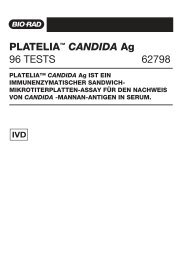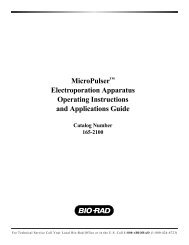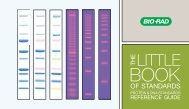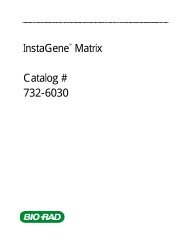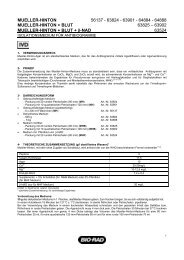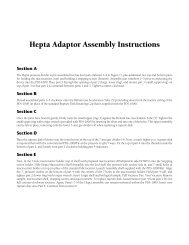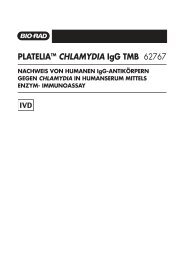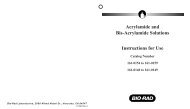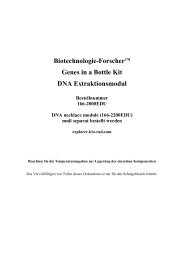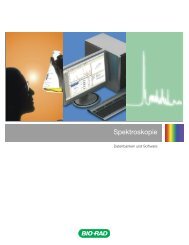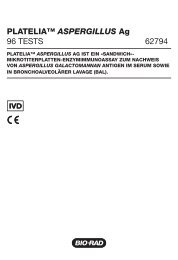Protein Expression and Purification Series - Bio-Rad
Protein Expression and Purification Series - Bio-Rad
Protein Expression and Purification Series - Bio-Rad
You also want an ePaper? Increase the reach of your titles
YUMPU automatically turns print PDFs into web optimized ePapers that Google loves.
CHAPTER 8<br />
BIOLOGIC DUOFLOW<br />
PROTOCOL<br />
<strong>Protein</strong> <strong>Expression</strong> <strong>and</strong> <strong>Purification</strong> <strong>Series</strong><br />
at the inlet of the UV detector when all the tubing is filled with fluid, disconnecting the tubing where it<br />
attaches to the fraction collector, pushing all this fluid out, <strong>and</strong> measuring the volume.<br />
Using the calculation method, a loose estimate can be determined by calculating the delay volume of the<br />
tubing present.<br />
The orange PEEK tubing has an inner diameter (ID) of 0.0508 cm.<br />
The green PEEK tubing has an inner diameter (ID) of 0.0763 cm.<br />
The volume of fluid in a specific length (L) of tubing would be π x (ID/2) 2 x L.<br />
Therefore, as an example, assuming that green PEEK tubing is in place <strong>and</strong> that there are 30 cm of<br />
tubing between the UV detector <strong>and</strong> the fraction collector, the delay volume would be at a minimum:<br />
π x (0.0763 cm/2) 2 x 30 cm = 0.137 cm 3 or 0.137 ml<br />
As can be seen from the calculation, this is not a large volume. However, there are much larger delay<br />
volumes as part of the UV flow cell, conductivity flow cell <strong>and</strong> fittings. Since 1 ml fractions are being<br />
collected for the eluate, it can be assumed that the majority of the GST-DHFR-His will elute in fractions 7<br />
<strong>and</strong> 8 as shown in Figure 8.29. However, there might actually be some GST-DHFR-His in fraction 9 as well.<br />
Therefore, it is important not to discard any fractions until all analyses are done! In the case of the<br />
example shown above, the majority of GST-DHFR-His eluted in fractions 7 <strong>and</strong> 8 with some in 9.<br />
Two other fractions will also be examined. The flowthrough fraction that contains all proteins that did not<br />
bind to the column when the column was initially loaded with the soluble fraction, <strong>and</strong> the wash fraction<br />
that contains any proteins that were washed off when the imidizole level was increased to 4% (or 10 mM<br />
imidazole). Again, these fractions can be determined by looking at the chromatogram from the <strong>Bio</strong>Logic<br />
DuoFlow system run. For example, if delay volume is considered, the majority of the flowthrough fraction<br />
should be in fraction 2. The majority of the wash fractions would be in fractions 5–6 in the example<br />
chromatogram in Figure 8.29.<br />
Protocol<br />
Choosing your flowthrough fraction, wash fraction, <strong>and</strong> three eluted GST-DHFR-His fractions<br />
Examine your chromatogram <strong>and</strong> determine the fractions that you feel are most likely to contain your<br />
flowthrough <strong>and</strong> wash, <strong>and</strong> the three fractions that might contain your eluted GST-DHFR-His. Remember<br />
that the delay volume is probably between 0.5–1.0 ml depending on the tubing length of your instrument.<br />
Record the fraction numbers you will examine below.<br />
Flowthrough fraction : ____________________<br />
Wash fraction: __________________________<br />
First eluted GST-DHFR-His fraction: ________________________________<br />
Second eluted GST-DHFR-His fraction: ______________________________<br />
Third eluted GST-DHFR-His fraction: _______________________________<br />
188 Chapter 8: <strong>Purification</strong> Protocol for <strong>Bio</strong>Logic DuoFlow System




